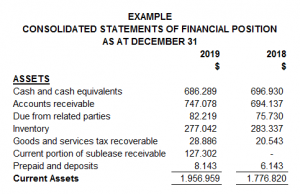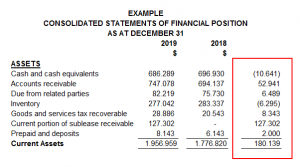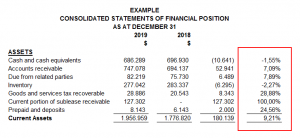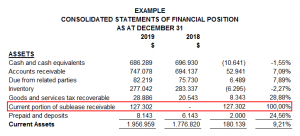
Analyzing Financial Statements: The Horizontal Method
The second method to analyze financial statements is the horizontal method. The horizontal method is used to analyze financial information in two fiscal years.
This method consists of comparing various financial statements, and it has a comparative evaluation between two years as less to identify the evolution of different accounts.
The method involves increasing and decreasing, a technique used to compare similar concepts on different dates. The object is to locate differences or inconsistent and analyze the accounts’ behavior year by year.
We determine if the variation is positive (increase) or negative (decrease).
To ensure a good analyze we recommend following the following steps:
Step #1
Having the financial statements in an Excel format will make it easier for the necessary calculations. Make sure you include the complete accounts next to their amounts and the two years correspondence. In the following example, we can see how it must look.
 |
Step #2
Include two columns next to the amounts inserted; the first one will be used to present the increases and decreases, and the second one will show the percentages.
The horizontal method takes each account’s value from the last year minus each account’s worth from the previous year.
For example, cash and cash equivalents from 2019 minus cash and its equivalents from 2018, as we can see as follow:
 |
Then, the result is divided by the total of the account from the last year. In this case, the result was divided by the total cash and cash equivalent from 2019 (the most recent year), obtaining 1.55%.
 |
Step #3
Once the percentages have been obtained, the user of the financial statements can select the account with more variation (a positive percentage if the account had an increase or a negative percentage if the account had a decrease) in the assets, liabilities, or income loss statement.
In the following example, we have the current portion of sublease receivable with 100% positive variation and cash and cash equivalents with 1.55% negative variation. The first have our special attention because it has more than 50%.
 |
Step #4
The analyst can start making questions about the variations; the first one could be which sublease did the company celebrate? In which operations or inversions the company expended cash?
You could have that information having an interview with the accounting department, the administrator, or even directly with the company’s owner, also. If the financial statement has been audited, you could read its notes.
With this method and the vertical method, it is essential to be sure about the accounts you are reviewing and investigate a lot about them. Make questions, look for supporting documents and call an expert if necessary.
Written by: Andrea Diaz
Related Articles:
Newsletters
No Results Found
The page you requested could not be found. Try refining your search, or use the navigation above to locate the post.
Events & Sponsorship
No Results Found
The page you requested could not be found. Try refining your search, or use the navigation above to locate the post.
Articles & Publications
10 red flags that could lead to a CRA audit
10 red flags that could lead to a CRA audit Audits can stem from things you do — or don't do — when filing your tax return. Typically, the tax agency will send out about 30,000 letters a year letting Canadians know they’re being audited. While that’s just a fraction...
CRA locking 800K Canadian taxpayers out of accounts
The Canada Revenue Agency has recently locked out 800,000 users from their online accounts, out of fear that people’s usernames and passwords have been hacked. Citing the cybersecurity risk of having this information in the hands of potentially bad actors, obtained...
Financial Statements: The Vertical Method
How to Analyze Financial Statements: Vertical Method As said in previous articles, we have two primary methods to analyze financial statements. Here you will learn how to use both steps by step. The first method, known as the vertical method, analyzes one fiscal...
Fundamentals of Financial Statements
Fundamentals of Financial Statements Analysis Financial Statement analysis is carried out through methods, often defined as techniques that allow knowing the entity's transactions on its financial situation and results. Based on the order to follow the analysis, these...
The U.S.’s New Law To “Ban” Shell Companies
The new U.S. Corporate Transparency Act (CTA), which passed in late 2020 as part of the National Defense Authorization Act, makes seemingly significant changes to the information required when incorporating a company in the U.S. While the legislation is a significant...